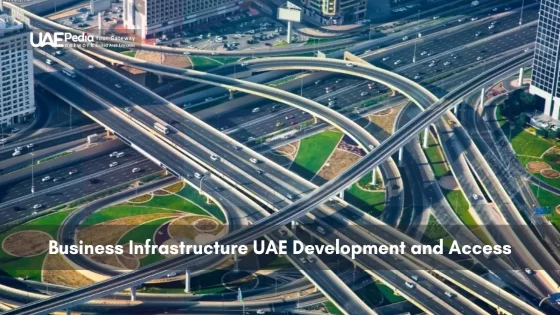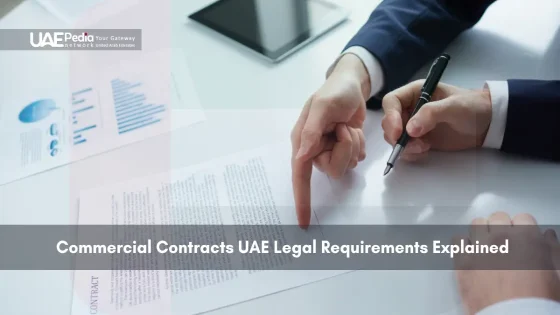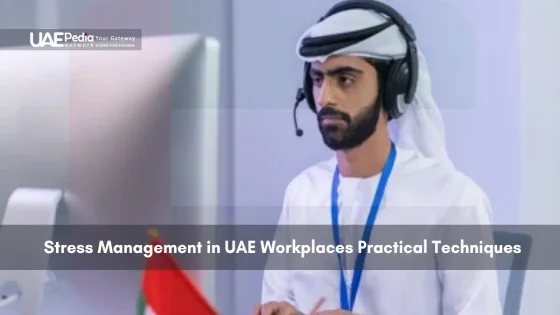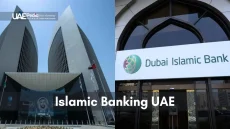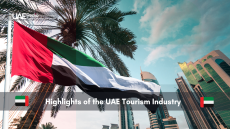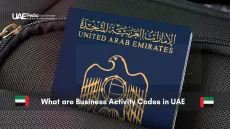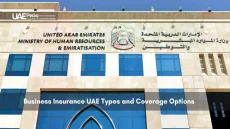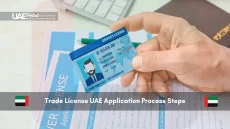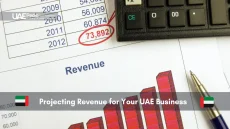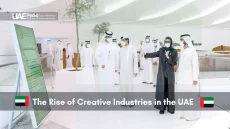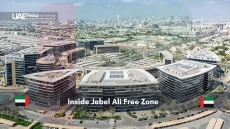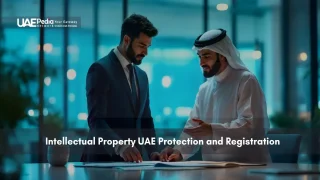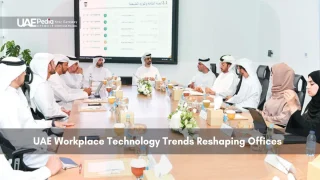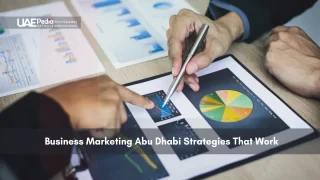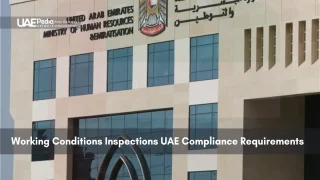The UAE’s economy grew over 8% in 2024, outpacing most G20 nations. This leap didn’t happen by accident. Behind the skyscrapers and luxury resorts lies a carefully engineered ecosystem blending cutting-edge tech with cultural wisdom, turning arid landscapes into thriving crossroads of commerce.
Twenty years ago, oil accounted for nearly 90% of the UAE’s government revenue. Today, smart cities like Dubai South hum with AI-managed logistics, while solar farms stretch across Abu Dhabi’s outskirts. Mega projects like Expo City Dubai showcase this shift, merging augmented reality experiences with carbon-neutral designs.
What makes this transformation unique? Government vision paired with relentless execution. Over $25 billion flows annually into transport networks and digital systems, creating seamless connections between ports, free zones, and the world’s busiest international airport. The result? A 24/7 gateway where ideas from Mumbai meet capital from Manhattan.
- Strategic investments transformed oil wealth into diversified tech and trade leadership
- Smart urban designs boost quality of life while slashing environmental impact
- Global connectivity positions the region as tomorrow’s innovation testing ground
UAE Infrastructure Evolution and Growth
The UAE has transitioned from oil rigs to solar farms and AI-powered cities. Twenty years back, this region’s economy leaned heavily on fossil fuels. Today, it’s crafting a blueprint that blends Bedouin wisdom with Tesla-level tech, turning sand into smart grids.
Vision 2030: From Oil Dependence to Diversification
The shift began with a simple truth: black gold wouldn’t fuel progress forever. By 2010, leaders launched Vision 2030—a strategic plan focused on tourism, renewable energy, and knowledge-based sectors. Take Abu Dhabi’s Masdar City: a car-free zone where buildings generate more power than they consume. Or Dubai’s Museum of the Future, where holograms teach visitors about AI ethics.
This isn’t just about shiny gadgets. The strategy connects ports, airports, and digital highways to position the country as a global trade hub. Each project, from hyperloop-linked Etihad Rail to smart ports, integrates seamlessly to create faster trade and travel routes.
IMF data show that non-oil activity now exceeds 70 % of UAE GDP—clear evidence that the diversification roadmap is delivering measurable results.Ref.: “Maccioni, F. (2024). IMF says UAE overall real GDP projected to grow 4% in 2024. Reuters.” [!]
“You Might Also Like: Investing in UAE’s Logistics and Transportation“
Sustainable Design and Digital Innovation in the UAE
Walk through Sharjah’s Aljada district, and you’ll find parks cooled by mist-generating palm trees and apartments with app-controlled water systems. These aren’t sci-fi fantasies—they’re today’s reality. The secret sauce? Pairing Emirati tarahum (compassion) with Swedish engineering and South Korean 5G networks.
Government strategies like the 2050 Net Zero Initiative push this further. Solar plants now stretch across empty quarters, while AI optimizes Dubai’s metro schedules. As one planner told me: “The UAE’s urban strategies focus on building cities that balance economic vitality with quality of life.”
Sharjah field trials show dust build-up can slash PV output by 12.7 % in just five months, underscoring the need for stringent cleaning cycles in desert arrays.Ref.: “Hachicha, A.A., Al-Sawafta, I., & Said, Z. (2019). Impact of dust on the performance of solar photovoltaic (PV) systems under United Arab Emirates weather conditions. Renewable Energy.” [!]
UAE Business Infrastructure and Major Investments
The UAE features artificial islands, advanced rail networks, and sustainable urban projects transforming its landscape. Here, imagination isn’t just sketched on blueprints; it’s poured into steel and glass faster than a sandstorm sweeps across the dunes.
“Discover More: Solar Energy Opportunities in the UAE“
Major Projects in Dubai and Abu Dhabi
Take Palm Jebel Ali—Dubai’s newest palm-shaped island. It’s not just a real estate marvel. This project will house 35,000 families in solar-powered homes, with underwater villas offering views of coral reefs. Meanwhile, Abu Dhabi’s Yas Island evolves into a thrill-seeker’s paradise, blending Ferrari World’s speed with Louvre Abu Dhabi’s artistry.
Then there’s the Dubai-Abu Dhabi Hyperloop—a tube-based transport system promising 12-minute city hops. Think of it as teleportation for commuters. The hyperloop system aims to dramatically cut commute times between cities.
HyperloopTT estimates construction at US$20 – 40 million per km—capital outlays that demand rigorous ROI and lifecycle assessments before full-scale deployment.Ref.: “Geronimo, A. (2019). Dubai-Abu Dhabi Hyperloop to cost $20–40 million per kilometer. Tahawul Tech.” [!]
“Further Reading: Mohammed bin Rashid Al Maktoum Solar Park“
Connectivity Through Airports and Ports
Al Maktoum International Airport’s expansion isn’t just about size. By 2030, its automated cargo terminals are expected to handle 12 million tons of freight annually. Pair this with Etihad Rail’s 1,200 km network, and you’ve got goods moving from Fujairah ports to Saudi borders faster than a camel caravan.
Phase-two expansion will raise DWC’s cargo throughput to 12 million tonnes per year—eclipsing current leaders like MEM and PVG and redefining global freight capacity standards.Ref.: “Dubai Airports. (2024). Dubai World Central – Expansion. Dubai Airports.” [!]
These hubs aren’t mere transit points. They’re economic accelerators. A logistics CEO recently noted: “Our location turns 4-hour flights into 8-billion-dollar trade routes—connecting Mumbai’s markets with Milan’s fashion houses.”
Together, these ventures transform the region into a crossroads where investments meet innovation. They’re not just shaping skylines—they’re redrawing the map of global opportunity.
“Related Topics: Infrastructure Projects Shaping the UAE“
Innovative Technologies and Sustainable Solutions
The UAE’s agricultural innovations include solar-powered greenhouses producing crops in arid conditions. That’s not fantasy—it’s tomorrow’s reality taking shape across the Emirates today. Let’s peel back the curtain on the tech and teamwork rewriting the rules of urban living.
Smart City Initiatives and AI Integration
Dubai’s streets now “think” for themselves. Traffic lights adjust in real-time using AI cameras, while chatbots handle 82% of government services. At AI Retreat events, developers test systems that predict water leaks before pipes burst—like digital fortune-tellers for urban maintenance.
The city even appointed Chief AI Officers across all departments. One official shared: “We’re teaching machines local dialects so they understand requests like ‘Yalla, fix this pothole!’”
Dubai’s AI Strategy 2030 sets 81 projects aimed at cutting average journey times by 20 – 30 % through real-time signal optimisation and predictive mobility analytics.Ref.: “Kumar, A. (2025). Smarter streets: Dubai’s RTA unveils AI strategy with 81 projects, initiatives to cut your travel time by 30%. Gulf News.” [!]
Water Security, Desalination, and Renewable Energy
Imagine sipping lemonade cooled by ice made from treated wastewater. The Taweelah Reverse Osmosis Plant—the world’s largest—now turns seawater into drinking water using 40% less energy. Meanwhile, the Mohammed bin Rashid Solar Park stretches across 77 km², its panels angled like sunbathing camels.
Taweelah’s switch to low-carbon reverse-osmosis boosts energy efficiency by 96 % and cuts desalination emissions by 85 %, setting a global benchmark for water security projects.Ref.: “Smart Water Magazine Staff. (2023). Abu Dhabi’s Taweelah plant now the largest commercially operating RO facility in the world. Smart Water Magazine.” [!]
These future-proof strategies aren’t just eco-friendly. They’re economic engines, slashing water costs by 30% while creating 5,000 green jobs annually.
“Related Articles: Business Activity UAE Sectors Showing Growth“
Public-Private Partnerships and Government Strategies
When tech meets tradition, magic happens. Private investors fund 60% of Masdar City’s wind farms, while the government guarantees fair returns. The model works: Dubai’s solar park attracted $13.7 billion from 23 countries—proving sustainability sells.
| Project | Technology | Impact |
|---|---|---|
| Smart Traffic System | AI cameras + IoT sensors | 30% less congestion |
| Taweelah Plant | Reverse osmosis | 909M liters/day |
| Solar Park Phase V | Bifacial panels | 1.8M homes powered |
As one engineer told me while walking through a solar field: “We’re not just building projects—we’re coding the future into every panel and pipeline.” The desert’s becoming a classroom where the world learns how tomorrow works.
“Read More: Dubai Hyperloop Project Current Status and Future Timeline“
Future Growth and Global Impact of the UAE
What does tomorrow’s blueprint for progress look like? Picture a thriving crossroads where solar-powered metros glide beneath AI-optimized skylines, and digital trade routes pulse with goods and ideas. This isn’t science fiction—it’s the Emirates’ playbook for rewriting global rules.
From hyperloop networks to carbon-neutral cities, every innovation here serves a grander vision. Strategic investments in transportation and tech aren’t just reshaping skylines—they’re crafting a template for how nations can balance economic growth with environmental care. Recent reports show the region’s professional services sector expanding by 15% annually, fueling industries from robotics to renewable energy.
“Explore More:
The magic lies in how these pieces seamlessly snap together. Smart ports sync with drone delivery systems. Green urban designs attract top talent seeking quality living. As one developer quipped: “We’re building cities that learn—adapting faster than a desert fox changes direction.”
Looking ahead, the Emirates positions itself as a dynamic laboratory for the world. With every solar panel installed and startup hub launched, it proves that thoughtful planning and bold innovation can coexist. For investors and dreamers alike, this is where tomorrow’s trade routes begin—and where the future gets its address.
Through Vision 2030 plans, Emirates like Dubai and Abu Dhabi are investing heavily in tourism, tech, and renewable energy. Projects like Masdar City and Dubai’s Expo 2020 site repurposing show this pivot, creating jobs in sectors like AI and clean energy while reducing oil dependence.
Jebel Ali Port remains the Middle East’s busiest cargo hub, while Etihad Rail’s 1,200 km network links all seven emirates. Dubai International Airport’s expansion and Abu Dhabi’s new Midfield Terminal amplify global connectivity, slashing shipping times for goods from Asia to Europe.
Dubai’s “Paperless Strategy” digitizes government services, while AI-powered traffic systems in Abu Dhabi cut congestion. Sensor-driven utilities in Sustainable City and solar-powered desalination plants showcase how tech tackles water security and urban efficiency challenges.
Tax-free zones like DIFC and ADGM offer 100% foreign ownership, while top-tier airports and ports ease logistics. The Golden Visa program attracts talent, and partnerships like G42’s AI healthcare projects create fertile ground for R&D-driven industries.
Abu Dhabi’s Barakah Nuclear Plant and Dubai’s Mohammed bin Rashid Solar Park aim for 50% clean energy by 2050. Green building codes mandate eco-design, and mangrove restoration projects offset carbon footprints from mega-developments like Yas Island.
